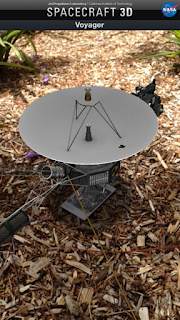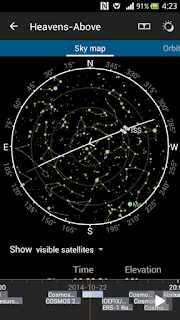El Universo en tu bolsillo.
Algunas apps y referencias para hacer y enseñar astronomía con smartphones:
Los smartphones son herramientas muy versátiles, tal vez de las más variadas y difundidas en la historia de la humanidad. Apartarlos por un momento de sus cotidianas aplicaciones para hacer algo diferente como explorar el universo es como cuando Galileo Galilei apartó al telescopio de su uso terrenal o náutico para dirigirlo al cielo y por primera vez descubrir maravillas nunca antes observadas.
Nota "Astronomía con Smartphone":
http://fisicamartin.blogspot.com.uy/2017/10/astronomia-con-smartphone.html
Presentación "Nuevas ecnologías en Educación. Astronomía Ciudadana"
Escuela Nacional de Astronomía IAU100, La Paloma, 2019.
https://fisicamartin.blogspot.com/2019/09/tecnologia-y-educacion-en-astronomia.html
Referencias:
Ver otras referencias sobre física en las pestañas "References" y "Works".
Michael T. Fitzgerald, David H. McKinnon, Lena Danaia, Sandra Woodward (2011).
"Using Smartphone Camera Technology to Explore StellarParallax: Method, Results, and Reactions"
Astronomy Education Review 10(1), 010108.
Andrew Fraknoi (2011).
"Astronomy Apps for Mobile Devices, A First Catalog"
Astronomy Education Review 10(1), 010302.
Becciani, U., Massimino, P., Costa, A., Gheller, C., Grillo, A., Krokos, M. (2011).
"Large-Scale Astrophysical Visualization on Smartphones"
Astronomical Data Analysis Software and Systems XX. ASP Conference Proceedings, Vol. 442.
Robert M. Gill and Michael J. Burin (2013).
"Enhancing the Introductory Astronomical Experience with the Use of a Tablet and Telescope"
The Physics Teacher, 51, 87.
K. Tian; M. Endo; M. Urata; K. Mouri; T. Yasuda (2014).
"Lunar Observation Support System Using Smartphone AR for Astronomy Education"
International Journal of Interactive Mobile Technologies, 8(1), 32-39.
Ke Tian, Mamoru Endo, Mayu Urata, Katsuhiro Mouri, and Takami Yasuda (2014).
"Multi-Viewpoint Smartphone AR-Based Learning System for Astronomical Observation"
International Journal of Computer Theory and Engineering, 6(5), 396-400.
Marcus Meißner. Hendrik Haertig (2014).
"Smartphone astronomy"
The Physics Teacher, 52, 440.
Lukas Schellenberg (2015).
"Revisiting smartphone astronomy"
The Physics Teacher, 53, 4.
Azael Barrera-Garrido (2015).
"Analyzing planetary transits with a smartphone"
The Physics Teacher 53, 179.
Andrew Symes (2015).
Proyecto: "Smartphone Astrophotography"
Rebecca Vieyra (2016).
Enseñando astronomía con smartphones: "Reason for the Season"
William Baird, Jeffery Secrest, Clifford Padgett, Wayne Johnson and Claire Hagrelius (2016).
"Smartphones and Time Zones"
The Physics Teacher 54, 351.
Entrevista en Radio Uruguay (SobreCiencia) a Daniel Gastelú (2016)
“Smartphones al cielo”: un programa que mejora la enseñanza de la astronomía mediante el uso de teléfonos inteligentes.
Jeremy Durelle, Jennifer Jones, Steven Merriman, and Aurelian Balan (2017)
"A smartphone-based introductory astronomy experiment: Seasons investigation"
The Physics Teacher 55, 122.
Julie Ziffer, William Morse, Tyler Nelson, Paul Nakroshis, Benjamin T. Rudnick, Max Brautigam, and Wesley Parker (2019)
"Practicing Spatial Relationship Skills Using an Asteroid 3-D Tool"
The Physics Teacher 57, 14.
Nota de blog Martín Monteiro:
Midiendo curva de luz de asteroides a escala con smartphone
Apps:
Ver otras apps para hacer física en general en la pestaña "Apps".
 Stellarium Mobile
Stellarium MobileStellarium Mobile Sky Map is a fully-featured planetarium for your phone. It shows a realistic and accurate night sky map, just like what you see with the naked eye, binoculars or a telescope.
The sensor control will also enable you to identify a star in just a few seconds, just by pointing the phone at the sky!
Catalog of over 600,000 stars displayed as a real time zoomable sky map
 Mobile Observatory
Mobile ObservatoryDo you want to know if the next lunar eclipse is visible from your location or when the next bright comet is visible? Would you like to be notified by your smart phone next time, Jupiter and the Moon meet in the sky? Do you want to know what the blazing bright object in the evening sky is? Do you want to be always up-to-date which celestial events that are visible from your location? Then this app is a must-have for you!
Provides you with loads of detailed extra information on stars, planets, deep sky objects, meteor showers, comets, asteroids, lunar and solar eclipses as well as detailed ephemeris of all included sky objects and an interactive top-down view of the Solar System. All that in just one app!
 Sky Map
Sky MapSky Map is a hand-held planetarium for your Android device. Use it to identify stars, planets, nebulae and more.
Originally developed as Google Sky Map, it has now been donated and open sourced
 SkEye
SkEyeSkEye is an advanced Planetarium that can also be used as a PUSHTO guide for telescopes.
Ever wondered what objects are up in the sky? Now you can get familiar with Astronomy by identifying stars, planets, and constellations. Also look up deep sky objects from the Messier and NGC catalogs.
 SkyORB
SkyORBSkyORB is a fast and lightweight astronomy app including a 3D star map, 3D planetarium, ephemeris with notifications, search engine, sun clock, point to sky, weather, and more.
 Solar System Scope
Solar System Scope3D simulation of the Solar System and night sky - real time virtual orrery and observatory:
- Heliocentric view with real-time positions of planets and planetary orbits
- Schematic and realistic sizes of the planets and distances between them
- Movement of the planets in time to see how they move in relation to each other - Virtual Orrery
- Planetary exploration with info texts, images and additional views such as structure
- Moons (Galilean moons, Deimos & Phobos, Titan and 15 others)
- Dwarf planets (Pluto, Ceres, Haumea, Makemake. Eris) and their orbits
- Comets (Siding Spring, Lovejoy 2013, Lovejoy 2011, Panstarrs, ISON, Halley, 67P, 209P) - positions and trajectories
- Spacecraft Rosetta and its journey to comet 67P/Churyumov–Gerasimenko
 Star Chart
Star ChartLook through the eyes of your Android device to see a virtual window into the whole visible universe.
All you have to do is point your Android deviceº at the sky and Star Chart will tell you exactly what you are looking at.
 Sun Surveyor
Sun SurveyorSun Surveyor Lite predicts and visualizes Sun, Sunrise and Sunset positions and times with a 3D Compass
 NASA Space Weather
NASA Space WeatherThe NASA Space Weather App provides access to space environment information from the sun to the earth, giving users a look at complex physical processes as they evolve, and how these processes affect the near earth space environment. Enormous explosions of gas and charged particles from the sun, known as Coronal Mass Ejections or CMEs, can be viewed on the NASA Space Weather App minutes after an eruption has been observed from satellites like the joint European Space Agency and NASA mission Solar and Heliospheric Observatory (SOHO), NASA’s Solar Terrestrial Relations Observatory (STEREO), as well as NASA’s Solar Dynamics Observatory ( SDO ).
 NASA
NASACome explore with NASA and discover the latest images, videos, mission information, news, feature stories, tweets, NASA TV and featured content with the NASA app for Android.
 Spacecraft 3D
Spacecraft 3DNASA's Spacecraft 3D is an augmented reality (AR) application that lets you learn about and interact with a variety of spacecraft that are used to explore our solar system, study Earth, and observe the universe. Using a printed AR Target and the camera on your mobile device, you can get up close with these robotic explorers, see how they move, and learn about the engineering feats used to expand our knowledge and understanding of space.
 Heavens-Above
Heavens-AboveWhen can I see the ISS? What's that light in the sky? The official Heavens-Above app provides you with precise pass predictions for the ISS, visible satellites, Iridium flares and radio satellites.
 ISS Detector Satellite Tracker
ISS Detector Satellite TrackerISS Detector will tell you when and where to look for the International Space Station or Iridium flares. You get an alarm a few minutes before a pass. You will never miss a pass of the International Space Station and you will never miss the bright flashes of the iridium communication satellites. ISS Detector will also check if the weather conditions are right.







